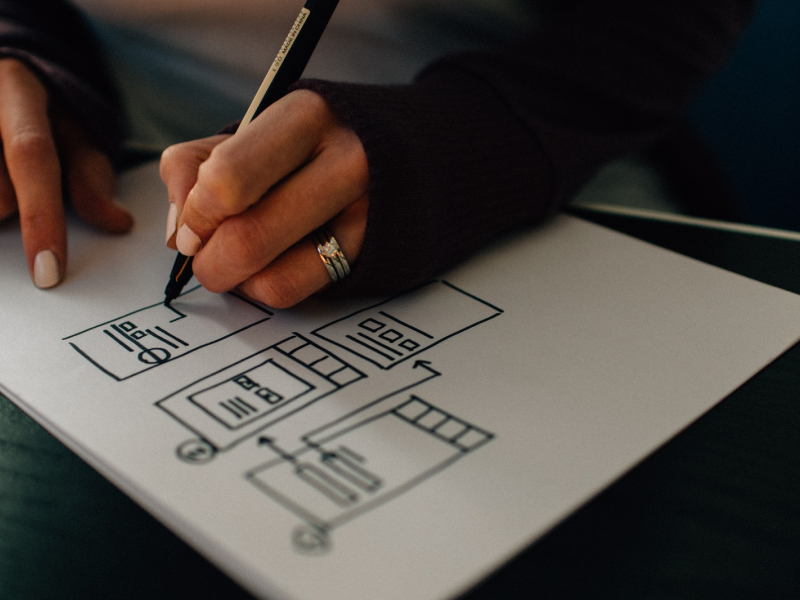From the apps we use on our smartphones to the websites we browse on our computers, software shapes our interactions and experiences. According to the U.S. Bureau of Labor Statistics, the employment of software developers, which includes digital product designers, is projected to grow 22 percent from 2020 to 2030, much faster than the average for all occupations.
User-centered problem solving
Central to digital product design is the ethos of user-centered problem solving, which stresses the importance of deeply comprehending and addressing the needs, desires, and challenges faced by end-users – based on thorough research and engagement to gather insights directly from the target audience.
According to a study by the Design Management Institute, design-driven companies outperformed the S&P 500 by 219% over a decade, showcasing the impact of user-centered problem-solving on business success.
Grounding their designs in actual user feedback gives companies what they need to create products that resonate more effectively with their users, enhancing user satisfaction, loyalty, and ultimately, the success of the product in the market.
Empathy in design
Empathy is one of the core pillars of user-centered design – stepping into the shoes of the users, and understanding their context, emotions, and challenges when interacting with a product. Empathetic designers strive to create experiences that resonate with users on a personal level.
This empathy looks at the surface-level user perspective and dives deep into the broader context of usage, such as their overall environment, circumstances, and the various factors that influence their experience. Specifically, this context includes the physical, social, and cultural context in which the product is used.
Designers consider factors like where, when, and how users will interact with the product. For instance, a user interacting with a mobile app at home may have different needs and constraints than one using the app in a busy subway station.
Setting goals and understanding the audience
Setting goals and understanding the audience is essential in expert product design. The objective centers around more than simply crafting a visually attractive interface; the aim is to create a product that fulfills its intended function with precision. Designers are tasked with aligning user goals with business objectives, a balance that is critical for the product’s success.
Techniques such as developing user personas and applying the “jobs to be done” framework are key in gathering insights into the audience’s needs and motivations.
- User personas: Creating user personas involves assembling comprehensive profiles that represent ideal users, based on research and data. These personas help designers and product teams visualize the end-users, guiding the creation of features and interfaces that resonate with the target audience.
- “Jobs to be done” framework: On the other hand, the “jobs to be done” framework focuses on understanding the tasks users aim to accomplish with the product, offering a lens through which designers can view the product from the users’ perspective. Employing these methodologies enables designers to craft products that not only meet users’ expectations but also align with the strategic goals of the business.
Problem framing and idea generation
Framing the problem accurately is a highly important initial step in the journey toward crafting impactful solutions. Techniques such as “The Five Whys” encourage designers to probe deeply and identify the underlying issues instead of superficially addressing symptoms.
When the problem is framed with precision, the foundation for generating effective solutions is established. Idea generation thrives on a deep comprehension of the users and their challenges. In this phase, collaboration emerges as a powerful tool, as it brings together varied perspectives, fostering an environment where innovative solutions can flourish.
Engaging with a diverse group during idea generation can unveil unique insights and approaches, enhancing the solution’s relevance and creativity.
User testing and feedback
Designing without user input is fraught with risks, as assumptions may lead designers astray. Engaging with users through prototypes, beta versions, or A/B testing offers a direct line to valuable insights. These methods establish a feedback loop, integral for refining the product to better match user needs and expectations.
User feedback acts as a guiding light, highlighting what resonates with users and what requires adjustment. In response to this feedback, designers iterate on the product, aligning it more closely with user requirements and enhancing its effectiveness in solving their problems.
Through both iterative testing and user engagement, the product evolves, incrementally improving and better serving its intended audience.
User interface and experience-first design
With the establishment of a user-centered approach to problem-solving, attention transitions towards the actual design phase of the product, addressing both its visual and interactive dimensions. This phase is key in shaping how users perceive and engage with the product, influencing their satisfaction and overall experience.
UX design and user flows
In User Experience (UX) design, the aim is to create an experience that is both seamless and intuitive for users. Designers leverage wireframes to map out user flows, providing a visual representation of a user’s journey through the product.
These wireframes are great for pinpointing potential issues or complexities that could disrupt the user experience. Crafting a coherent and thoughtful user flow is essential to facilitate a positive and engaging interaction with the product.
Visual and UI design
The visual dimension of a digital product covers a major part of user interactions, encompassing elements like color schemes, typography, and imagery.
Effective visual design both resonates with the brand’s identity and caters to user intuitiveness. The visual elements need to maintain consistency throughout the product to reinforce a sense of familiarity and reliability. A well-executed visual and UI design improves user engagement and contributes to the product’s identity, making it more memorable and user-friendly.
Motion and interaction design
Adding motion and interaction elements to the design can greatly enhance user engagement. Micro-interactions, subtle animations, and transitions guide users through the product and make interactions more enjoyable. However, these dynamic elements should be deliberate and purposeful, rather than distracting or excessive.
Content design and accessibility
Effective content design is about communicating clearly with users, involving crafting text, images, and multimedia that not only convey information but also reflect the product’s brand voice.
Accessibility considerations ensure that the product is usable by people with various abilities – and provides alternative text for images, ensuring proper contrast for text, and considering keyboard navigation for those who rely on it.
Collaboration and communication to discover pragmatic solutions
For a design to truly resonate and achieve its intended goals, there must be intentional collaboration and communication within the team.
When team members from different disciplines—such as designers, developers, and project managers—come together with a shared understanding and common goals, the potential for innovation and quality in design is exponentially increased.
Open channels of communication enable the sharing of ideas, feedback, and insights, which are invaluable in refining the design and ensuring that it aligns with the project’s objectives and user needs.
Effective documentation
Maintaining clear and concise documentation of design decisions is a fundamental practice that benefits all team members and stakeholders involved in a project. Such documentation acts as a comprehensive reference point, detailing the rationale behind design choices, the objectives they aim to achieve, and the methodologies employed.
When designers articulate their thought processes and decisions in a documented format, it facilitates a deeper understanding and appreciation among team members and stakeholders, fostering a cohesive approach to the project. Effective documentation serves as a valuable resource for future projects, enabling teams to build on past learnings and successes.
Feedback and team alignment
Feedback is a core element in the design process, where designers are encouraged to embrace critiques and suggestions to refine their work. A culture that values open communication and feedback contributes to aesthetically pleasing designs, as well as user-centric and functional.
Engaging with team members from different domains like engineering, product management, and marketing enriches the design process. Engineers bring a technical perspective, product managers offer strategic insights, and marketers provide a customer-centric viewpoint.
When these diverse perspectives converge, the outcome is a product design that resonates on multiple levels, meeting technical requirements, strategic goals, and market needs.
Collaborating with engineering
Designers bring vision and creativity to the table, while engineers contribute their technical expertise to transform concepts into tangible products. Ongoing dialogue between these two groups ensures that design intentions are fully understood and accurately translated into the final product.
Challenges often arise around technical constraints and feasibility, yet these discussions are opportunities for creative problem-solving and innovation. Through mutual respect and collaboration, designers and engineers work together to face these challenges, ensuring the final product aligns with the original design vision while remaining technically robust.
Final thoughts
Digital product design is a complex discipline that combines creativity, empathy, and technical expertise, aimed at solving real-world problems for users while aligning with business goals. The pillars of user-centered problem solving, user interface and experience design, and collaboration and communication form the foundation of effective product design.
The field is constantly evolving, with new tools and techniques emerging regularly. Staying up-to-date with industry trends and best practices can help designers hone their skills and create products that resonate with users and drive business success.




